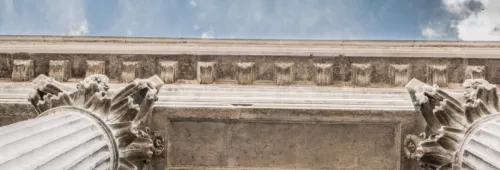Fittingly, Frank McKelvey’s painting of the opening ceremony for the Royal Courts of Justice in 1931 hangs in the Royal Courts of Justice. Among the platform dignitaries depicted as sitting with the then Lord Chief Justice are the Moderator of the General Assembly of the Presbyterian Church in Ireland, the Church of Ireland Bishop of Down, Connor and Dromore, and the President of the Methodist Church in Ireland.
While none of these three Churchmen can be said to fully represent the Lutheran (as opposed to a Calvinist or Anglican) Reformation, they may be said to represent a vivid form of Protestant civic culture in Northern Ireland that is unimaginable without Martin Luther’s contribution to Church history. Put another way, it is only a Protestant civic culture that Frank McKelvey’s painting displays.
That Protestant civic culture has to be distinguished from the Northern Ireland constitution as legally expressed in the Government of Ireland 1920. This was a constitution that was, as far as possible given the legal imagination of the time, confessionally neutral in much the same way that the constitution for the Home Rule administration contemplated by the Government of Ireland Act 1914 was neutral.
If one can detect a feature that is distinctly Lutheran in the Protestant civic culture that informed the law and government of Northern Ireland between 1921 and 1972 it is in the unqualified support that civic culture largely gave to the state in Northern Ireland and the trust placed by that civic culture in that state.
I say ‘largely’ because there were exceptions. In 1936 the Rev Dr T.M. Johnstone, a notable temperance advocate fell foul of the High Court as a result of his energetic temperance advocacy and was punished for contempt of Court. Attempts were made to discuss his case in Stormont but were ruled out of order by the Speaker leading at least one MP to wonder at the extent of judicial power.
Although temperance was, and is, a strong feature of Irish Presbyterianism, temperance is not, and never has been, either a creedal obligation for Presbyterians nor, (and far less) a creedal obligation generally for Protestants.
Presbyterians have always been found who are not slow to point out when Caesar was trying to take, or taking, more than his due. The strong and assertive character of Presbyterianism in Northern Ireland has combined with more naturally erastian ecclesial traditions has meant that the search for the impact of the Lutheran Reformation in the law and government of Northern Ireland does not produce neat results.
Even within Presbyterianism the Rev T.M. Johnstone cannot be regarded as typical any more than Lord MacDermott, (a son of the Manse, a member of the Ulster Volunteer Force before the Great War and widely regarded as the finest Lord Chief Justice of Northern Ireland) could be described as typical.
Today in the Courts of Northern Ireland, the only observable trace of the Reformation lies in the proffer of a ‘Protestant’ version of the New Testament for the purposes of taking the oath as a witness. A witness who objects to the New Testament will be able to take an oath in another way that is regarded as binding in conscience (or to affirm) but in the normal course of court business it is the New Testament that will ordinarily be offered first.
In those remaining courtrooms in Northern Ireland where, by section 66 of the Justice (Northern Ireland) Act 2002, the Royal Arms may still be displayed, the first word visible on the heraldic device is “Dieu”. The limitation introduced by section 66 was directed more at a visible presence of royalty in the Courts of Northern Ireland than at an acknowledgement of God. But it is difficult to avoid the melancholy thought that the material presence of the word ‘Dieu’ in Court (a heartening presence for anyone with basic French or who otherwise knows what the word means) is even a collateral casualty of the politics of nationality. Is that melancholy tempered at all by the thought that the loss of such a presence will be felt by those for whom the events of 1517 are simply a blessing as well as those for whom they are a more ambiguous inheritance?

